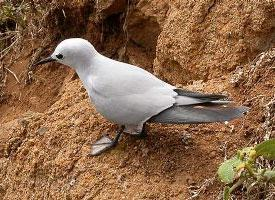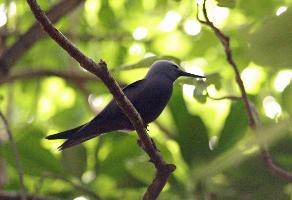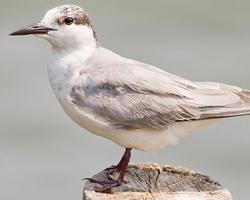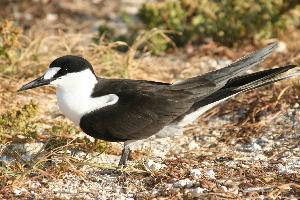
Poids et mesures
| Longueur | de 28 à 31 cm |
|---|---|
| Envergure des ailes | de 46 à 60 cm |
Description de l'animal
The Grey Noddy, scientifically named Anous albivitta, is a captivating seabird that belongs to the Laridae family, which encompasses gulls, terns, and their kin. This species exhibits a unique blend of subtlety and grace, making it a fascinating subject for birdwatchers and ornithologists alike.Physical Characteristics:
The Grey Noddy is a medium-sized bird, with a body length typically ranging from 30 to 35 centimeters and a wingspan that extends approximately 60 to 70 centimeters. It possesses a slender build, characterized by its light grey plumage, which covers most of its body. The bird's underparts are a slightly paler shade of grey, providing a subtle contrast. One of the most distinctive features of the Grey Noddy is its white cap, which stands out against its grey body. Its bill is slender and black, perfectly adapted for catching fish and small marine invertebrates. The eyes are dark and expressive, while the legs and feet exhibit a dark coloration, blending seamlessly with its overall color scheme.
Habitat and Distribution:
The Grey Noddy is predominantly found in tropical and subtropical regions, favoring the open ocean and coastal areas. Its breeding range is quite dispersed, with colonies located on islands in the Pacific and Atlantic Oceans, including parts of the Caribbean. These birds are particularly adept at nesting on rocky cliffs and outcrops, as well as sandy beaches, where they can be closer to their feeding grounds.
Behavior and Diet:
The diet of the Grey Noddy mainly consists of small fish and marine invertebrates, which it skillfully catches by skimming the ocean surface or diving from a low height. They are known for their agile flight and their ability to deftly maneuver over the waves, showcasing their mastery of the air-sea interface.
Breeding and Social Structure:
Grey Noddies are colonial breeders, often forming large, densely packed colonies during the breeding season. They exhibit a high degree of fidelity to their nesting sites, returning year after year to the same location. Nests are typically constructed from seaweed, feathers, and other available materials, and are placed on the ground or in crevices among rocks. A single egg is laid per breeding attempt, with both parents sharing incubation duties and later, the feeding and protection of the chick.
Conservation Status:
Currently, the Grey Noddy is not considered to be under significant threat, and it is classified as Least Concern by the International Union for Conservation of Nature (IUCN). However, like many seabird species, it faces potential threats from habitat destruction, pollution, and the effects of climate change, which could impact its food supply and nesting sites.
In conclusion, the Grey Noddy is a remarkable bird, whose grace and agility in its natural habitat make it a joy to observe. Its presence across the world's oceans serves as a reminder of the diversity and complexity of marine ecosystems, and the importance of preserving these environments for future generations.
Animaux similaires
Nouvelles photos d'animaux
Top 10 des animaux
- Dolphin gull (Leucophaeus scoresbii)
- Diana monkey (Cercopithecus diana)
- Moustached guenon (Cercopithecus cephus)
- Galápagos tortoise (Geochelone nigra complex)
- Japanese macaque (Macaca fuscata)
- Russian tortoise (Testudo horsfieldii)
- Stone loach (Barbatula barbatula)
- Greek tortoise (Testudo graeca)
- Common flying dragon (Draco volans)
- Vendace (Coregonus albula)


